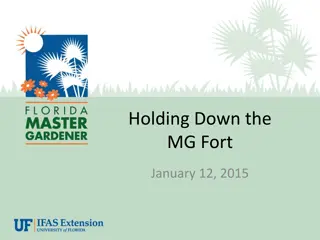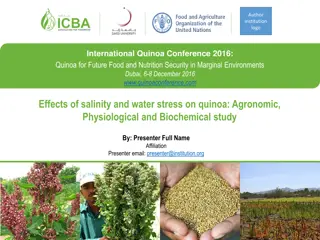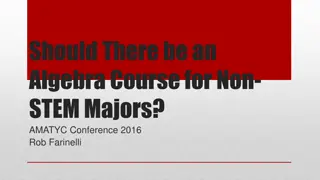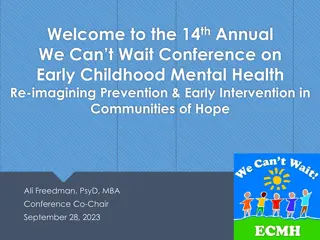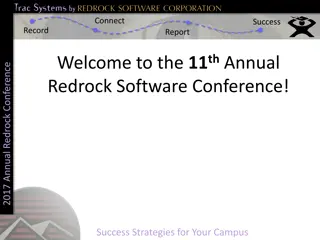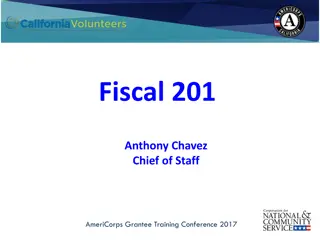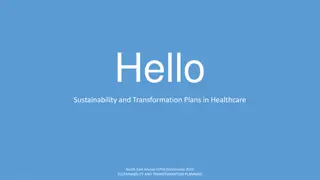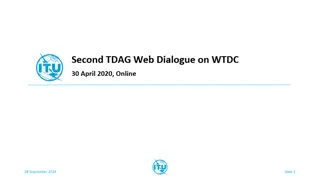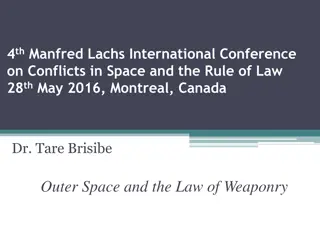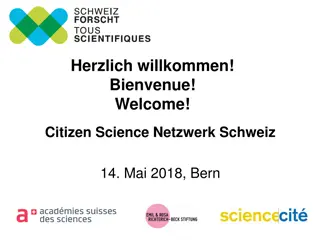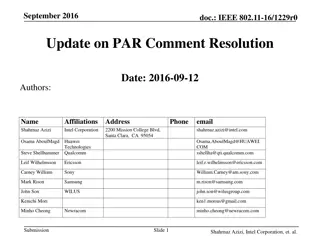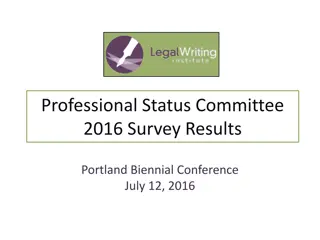
Creating Multi-Institutional Health Pathways through AVATAR Project
Explore the AVATAR project's initiative for creating curriculum pathways in health careers through collaboration with educational institutions. Learn about the project's impact on student success and post-secondary education access. Join the critical conversations on educational policies, practices, and career readiness standards.
Download Presentation

Please find below an Image/Link to download the presentation.
The content on the website is provided AS IS for your information and personal use only. It may not be sold, licensed, or shared on other websites without obtaining consent from the author. If you encounter any issues during the download, it is possible that the publisher has removed the file from their server.
You are allowed to download the files provided on this website for personal or commercial use, subject to the condition that they are used lawfully. All files are the property of their respective owners.
The content on the website is provided AS IS for your information and personal use only. It may not be sold, licensed, or shared on other websites without obtaining consent from the author.
E N D
Presentation Transcript
1 Creating Curriculum for Multi- Institutional Health Career Pathways through Partnership NISOD 2016 International Conference, May 30, 2016; Austin, TX http://untavatar.org
2 Meet the Presenters Jean Keller will introduce the AVATAR project. Kathy Wright-Chapman will introduce an application facilitated by Texas Regional Education Service Center 11 for a partnership of school districts, community colleges, and universities. Michael Endy will explain the central role of Weatherford College in planning and development of the health career academies partnership. Mary Harris will lead reflection on lessons to be learned from application of the AVATAR model in a multi-institutional, career-focused context. http://untavatar.org
3 What is AVATAR?
4 Basic Facts: AVATAR Academic Vertical Alignment Training and Renewal First funded in 2011 by the Texas Higher Education Coordinating Board as part of its Closing the Gaps strategic plan Facilitated by the University of North Texas for the North Texas Regional P-16 Council, which serves the Dallas Fort Worth and Metroplex areas Active in 2015 in all 20 Education Service Center regions of the Texas Education Agency 1. 2. 3. 4. http://untavatar.org
6 S c a f f o l d i n g S c a f f o l d i n g S t u d e n t S t u d e n t S u c c e s s S u c c e s s AVATAR is a Partnership of Regional Leaders from these institutions http://untavatar.org
7 AVATAR enables Critical Conversations Post-Secondary Graduate Career Ready Secondary Graduate College/Career Ready Impact of Developmental Education and Texas Success Initiative Student Success Assessments Dual Credit, Early College High Schools Student Support Services Dual Credit, Early College High Schools Student Support Services Educational Policies & Practices Classroom Instruction, Textbooks Grading, etc. Discipline Specific Course Curriculum Educational Policies & Practices Classroom Instruction, Textbooks Grading, etc. Discipline Reference Course Profiles College & Career Readiness Standards Texas Essential Knowledge and Skills http://untavatar.org
Changing Focus of AVATAR 8 Close gaps in student access to and success in post- secondary education through collaboration focused on 2011-14: Vertical alignment of the core curriculum 2014-15: Vertical alignment through College Preparatory Courses in ELA and mathematics designed for high school students who are not college ready and may, according to local agreement, exempt the TSI (a provision of HB 5, 2013) 2015-16: Vertical alignment of curriculum arising from endorsement options offered by local high schools and continuation of work begun in earlier years (a provision of HB 5, 2013) 1. 2. 3. http://untavatar.org
9 High School Graduation Endorsement Options Enabled by HB 5 (TX Leg. 2013) Endorsements STEM (Science, Technology, Engineering, and Mathematics) Business and Industry Public Services Arts and Humanities Multidisciplinary Studies http://untavatar.org
10 How did Region 11 Facilitate the Work?
11 Texas Regional Education Service Centers (ESC) http://untavatar.org
12 ESC Region 11 serves: Counties: 10 Public School Districts: 77 Charter Schools: 62 Private Schools: 106 Educators: 69,310 Students: 569,487 http://untavatar.org
13 ESC Region 11 AVATAR Project Project focus emerged from an identified need of rural districts that struggle with IHE dual credit access, certification course access, certified personnel, course resources, and lack of funding for implementation of a more differentiated high school curriculum. http://untavatar.org
14 S c a f f o l d i n g S c a f f o l d i n g S t u d e n t S t u d e n t S u c c e s s S u c c e s s Th Health Careers Pathway Partnership in Region 11 included these institutions http://untavatar.org
15 ESC Region 11 AVATAR Project Focus Develop a Health Science Academy partnership comprised of rural districts, Two-Year IHEs, Four-Year IHEs, and Workforce/Industry leadership Design a Health Science Academy focused on an articulated set of high school courses supporting high school graduation endorsements, professional certifications, Two- Year IHE associate degree and/or Four-Year IHE degree Create a Health Science Academy course curriculum vertically aligned to the TEKS and College and Career Readiness Standards Provide Health Science Academy Initial courses in multiple formats (face-to-face and/or distance learning) beginning Fall 2016 Design and implement a sustainability plan 1. 2. 3. 4. 5. http://untavatar.org
16 THECB AVATAR Funding THECB AVATAR Project Total Funding - $8,500 District staff travel and meeting - $6,420.00 IHE staff stipend for meeting attendance - $1,680.00 ($50.00 per meeting) ESC Region 11 staff meeting travel and printing - $400.00 http://untavatar.org
17 ESC Region 11 AVATAR Project Overview Three Hour Partnership Meetings May 12, 2015 (AVATAR Project overview to selected 6 rural districts) June 25, 2015 (District partnership created and project focus discussed) September 21, 2015 ( 2 Two-Year and 2 Four-Year IHE Partners joined the project) November 18, 2015 (Two-Year IHE partner took the lead in developing course scope and sequence) December 17, 2015 (District and IHE key staff created a sub- committee to identify Academy specific courses) http://untavatar.org
18 ESC Region 11 AVATAR Project Overview Three Hour Partnership Meetings January 21, 2016: Report of sub-committee recommendations, and North Central Texas Workforce staff joined the meeting. February 21, 2016: District and IHE sub-committee met to fine tune Academy focus by identifying IHE courses, qualified teaching staff, certifications/licenses, resources, and creating an overall Academy plan to present to district school board, students, and families. April 7, 2016: District and IHE sub-committee report and identify implementation next steps. June 6. 2016: Discuss what is working and not working and schedule 2016-2017 partnership meetings . http://untavatar.org
19 What role was played by Weatherford College? http://untavatar.org
20 Weatherford College Facts Service Area: Hood, Parker, Palo Pinto, Wise (Region 11) and Jack (Region 9) Counties 25 public; 9 other secondary education partners 5500 semester enrollment 20% dual credit enrollment 450 health science slots http://untavatar.org
21 AVATAR Health Science IHE Challenges Remote, Multisite Delivery Partner Desirables Embedded Programs Licensure Requirements Nursing Pre-med Program Costs Guaranteed Entry Facilities Immediate Access Equipment Reduced Cost Staffing Clinical Sites http://untavatar.org
22 AVATAR Health Science Adoptions College Academies Decatur, Weatherford, Rural Alliance Options Prep Programs Nursing Pre-med Ongoing Development of VN Pilot Program Related Health Fields Human Services Provider 2 Districts to Ranger Emergency Services VN or Phlebotomy http://untavatar.org
23 What Can We Learn from this Multi- institutional, Career-focused Curriculum Example?
24 Why was it successful? http://untavatar.org
25 Why was it successful? The vision of a health career pathway was shared among the partners. The right education partners were at the table. Institutional leaders were involved, active, and able to call others to the table. Meetings were well and dependably facilitated. People did their homework on time. Group members were open in sharing problems and challenges. Higher education members collaborated. http://untavatar.org
26 What could have been done differently? http://untavatar.org
27 What could have been done differently? Business partners could have been active in the curriculum planning. Plans could have been made for sustainability through an MOU that provided for 1) development and vertical alignment of curriculum, 2) on-going administrative oversight, and 3) evaluation. Plans might have been made for multi-institutional professional development of faculty. Short-term funding may be available through Workforce Solutions. http://untavatar.org
28 Final thoughts? http://untavatar.org
29 Contact the Presenters Jean Keller, Professor, Kinesiology, Health Promotion,and Recreation, UNT, Denton, TX, 940 565- 3427, jean.keller@unt.edu Kathy Wright-Chapman, Director, Research and Evaluation, Region 11 Education Service Center, Fort Worth, TX, 817 740-7546, kwc@esc11.net Michael Endy, Executive Dean of Academics, Weatherford College, Weatherford, TX, 817 598- 6211, mendy@wc.edu Mary Harris, Professor Emeritus, Teacher Education and Administration, UNT, Denton, TX, 940 367-3026, mary.harris@unt.edu http://untavatar.org




